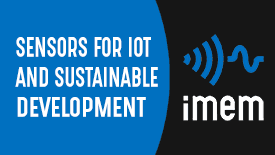Sensors for liquids and Biosensors
Gas and Volatile Organic Compound (VOC) sensors
The working principle of chemoresistive sensors, used for gases and other volatile organic compounds (VOCs), is based on the variation of their electrical conductivity when they are exposed and reacts with specific substances. By measuring their resistivity, it is so possible to measure the proportional amount of gas/VOC that is present in the surrounding environment.
This kind of sensors, mainly built around semiconducting metal oxides, is generally highly sensitive but cheap. This makes them of large interest for different applications in may fields, from safety and security controls to environmental pollution measure, from medical technologies to the industrial monitoring in production lines. Being small, cheap, and having usually a very low power consumption, these sensors are ideal for their use in distributed sensors networks and their integration in common use objects and tools, in view of expanding the possibilities of the emerging IOT ("Internet Of Things") technologies.


IMEM is developing materials and technologies for chemoresistive sensors based on oxide nanostructures. A twenty years long expertise in the growth of nanostructured materials, in their characterization (morphological, structural and functional), in the realization of devices and their test, as well as in data analysis and modelling, is today applied in this field.
X and gamma ray detectors
Nowadays ionizing radiation detectors are widely employed in several application fields. These include medical imaging (CT, SPECT), environmental monitoring (control of the background radiation and contaminated areas), homeland security (cargo and luggage control), industrial controls (material quality and/or foreign bodie checks) and astrophysics (study of X- and gamma-ray emission from celestial bodies).

In last decades the use of semiconductor devices is getting more and more important in these fields and they have replaced classical scintillators in various application. Semiconductor based detectors can achieve better energy resolution thanks to the direct conversion of incident radiation into electrical signal. In addition semiconductor materials, compared to scintillators, allow to achieve higher spatial resolution in imaging detectors. These characteristics make semiconductors the most advanced technology for radiation detection of X- and gamma-photons in the energy range betweeen 1 keV and 10 MeV.
Taking into account the key demands of radiation detector applications, several semiconductor materials have been studied after that year . The main requests for such materials are: I) high stopping power even for energetic radiations; II) spectroscopic capability; III) imaging capability with good spatial resolution; IV) possibility to operate at room temperature; V) excellent mechanical rigidity to fabricate compact and stable systems.
Among the compound semiconductors, Cadmium Zinc Telluride (CdZnTe or simply CZT) is one of the few materials that fulfills all the requirements listed above. CdZnTe represents the best compromise in terms of energy efficiency, high atomic number, resistivity, and room temperature operation capability.
CZT and the detectors made with this material have been studied at IMEM for more than 20 years and actually our Insitute has active collaboration with several national and international research groups and companies working in this field.
UV detectors
Explosives detectors
IOT and AI enabled sensing
Technologies for energy supply








